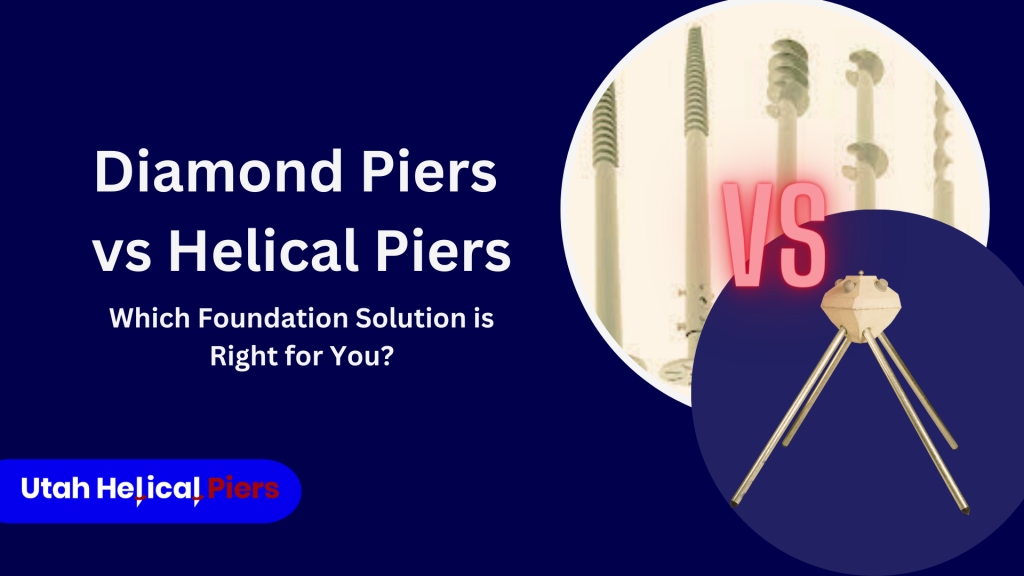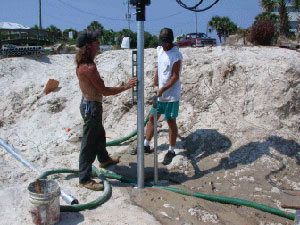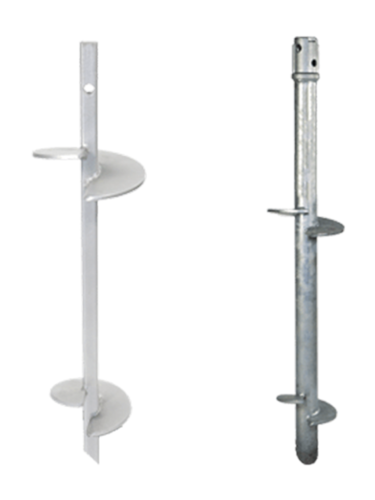
Are you in the market for a new foundation solution? As you navigate the world of construction and home improvement, you may have come across two popular options: Diamond Piers vs Helical Piers. Both offer unique benefits and advantages, but how do you know which one is the right choice for your project? In this article, we will delve into the details and help you make an informed decision.
Whether you’re building a new home, adding an extension, or repairing an existing foundation, understanding the differences between Diamond Piers and Helical Piers is crucial.
We’ll explore the key features, installation process, durability, and cost factors of each solution. By the end, you’ll have the knowledge you need to confidently choose the foundation solution that best fits your needs and ensures the long-term stability of your structure.
Let’s dive in and discover which pier is the perfect fit for your project!
Understanding foundation solutions
Before we dive into the specifics of Diamond Piers and Helical Piers, let’s first understand the importance of foundation solutions. The foundation is the backbone of any structure, providing stability and support. A strong and reliable foundation is essential to ensure the longevity and structural integrity of your building. When it comes to foundation solutions, there are various options available, each with its own advantages and limitations.
How Diamond Piers work
Diamond Piers is a unique foundation system that uses precast concrete piers with a diamond-shaped footing. The piers are driven into the ground using hydraulic equipment, creating a strong and stable base for your structure. The diamond-shaped footing provides increased load-bearing capacity and minimizes soil disturbance during installation. This innovative design allows for easy leveling and adjustment, making Diamond Piers a versatile solution for a wide range of projects.
One of the key features of Diamond Piers is their ability to be installed without the need for excavation or additional concrete. This reduces the time and cost associated with traditional foundation systems. Additionally, Diamond Piers are resistant to frost heave and can be used in areas with high water tables or expansive soils. These piers are also environmentally friendly, as they do not require the use of chemicals or other harmful substances during installation.
Advantages of Diamond Piers
Diamond Piers offers several advantages over traditional foundation solutions. Firstly, their unique design allows for quick and easy installation, saving both time and money. The precast concrete piers can be driven into the ground in a matter of hours, eliminating the need for time-consuming excavation and concrete pouring. This makes Diamond Piers an ideal choice for projects with tight timelines or budget constraints.
Another advantage of Diamond Piers is their versatility. The adjustable design of the piers allows for easy leveling and adjustment, making them suitable for a variety of soil conditions. Whether you’re building on clay, sand, or loam, Diamond Piers can provide a stable and reliable foundation. This flexibility is particularly beneficial in areas with varying soil types or challenging ground conditions.
In terms of durability, Diamond Piers are known for their long-lasting performance. The precast concrete piers are designed to withstand heavy loads and adverse weather conditions. They are resistant to frost heave, settling, and shifting, ensuring the stability of your structure for years to come. Diamond Piers also require minimal maintenance, making them a cost-effective and hassle-free foundation solution.
Limitations of Diamond Piers
While Diamond Piers offer many advantages, it’s important to consider their limitations as well. One limitation is the size and weight of the piers. Due to their solid concrete construction, Diamond Piers can be heavy and may require specialized equipment for installation. This can increase the cost and complexity of the project, especially in areas with limited access or tight spaces.
Another limitation is the depth to which Diamond Piers can be driven. The piers rely on the load-bearing capacity of the soil, and in some cases, the soil may not be suitable for deep installation. This can restrict the use of Diamond Piers in areas with weak or unstable soil conditions. It’s important to assess the soil composition and consult with a professional engineer before choosing Diamond Piers as your foundation solution.
The Procedure Of Helical Piers.
Helical piers, also known as screw piles or helical anchors, are a type of foundation that is used to support structures in a variety of conditions. They are made up of a steel shaft with helical plates attached to it, which are screwed into the ground using hydraulic equipment. The helical plates provide additional stability and load-bearing capacity, making helical piers suitable for a wide range of applications.
The installation process of helical piers is relatively quick and efficient, with minimal soil disturbance. The helical plates cut through the soil, creating a secure foundation that can support heavy loads. This makes helical piers an excellent choice for projects with challenging soil conditions or limited access.
Diamond Piers vs Helical Piers: See The Key Differences Side BY Side
| Serial No | Feature | Diamond Piers | Helical Piers |
|---|---|---|---|
| 1 | Stability | More stable than traditional round piers | Less stable than diamond piers |
| 2 | Ease of installation | Relatively easy to install | More difficult to install than diamond piers |
| 3 | Versatility | Less versatile than helical piers | More versatile than diamond piers |
| 4 | Cost | More expensive than helical piers | Less expensive than diamond piers |
| 5 | Load capacity | Higher load capacity than helical piers | Lower load capacity than diamond piers |
| 6 | Depth | Can be installed to greater depths than helical piers | Can be installed to shallower depths than diamond piers |
| 7 | Soil conditions | Can be installed in a wider range of soil conditions than helical piers | Can only be installed in certain soil conditions |
| 8 | Warranty | Longer warranty than helical piers | Shorter warranty than diamond piers |
Factors to consider when choosing a foundation solution
When choosing between Diamond Piers and Helical Piers, there are several factors to consider. Firstly, you need to assess the soil conditions and load-bearing capacity of the site. Both solutions have specific requirements and limitations when it comes to soil types and depths. It’s important to consult with a professional engineer or geotechnical expert to evaluate the suitability of each solution for your project.
The size and scope of your project should also be taken into account. Diamond Piers are often preferred for smaller projects or areas with limited access, as they can be installed without extensive excavation or concrete pouring. On the other hand, Helical Piers are suitable for a wide range of project sizes and can be adjusted to accommodate various soil conditions.
Cost is another important factor to consider. While both Diamond Piers and Helical Piers offer long-term durability and stability, their initial costs may vary. It’s important to obtain detailed quotes and compare the overall cost of each solution, including installation, materials, and any additional requirements. Keep in mind that the long-term benefits and savings of a reliable foundation can outweigh the initial cost.
Conclusion
Choosing the right foundation solution for your project is essential to ensure the long-term stability and durability of your structure. Diamond Piers and Helical Piers offer unique advantages and limitations that should be carefully considered. Understanding the key features, installation process, durability, and cost factors of each solution is crucial in making an informed decision.
Diamond Piers are known for their quick and easy installation, versatility, and long-lasting performance. They are a cost-effective and environmentally friendly option that can be adjusted to accommodate various soil conditions. However, limitations such as weight and depth restrictions should be taken into account.
On the other hand, Helical Piers offer versatility, strength, and minimal soil disturbance. They can be installed in various soil conditions and provide excellent load-bearing capacity. However, potential soil displacement and higher initial costs should be considered.
By assessing the soil conditions, project requirements, and cost factors, you can make an informed decision between Diamond Piers and Helical Piers. It’s important to consult with professionals and evaluate real-world case studies to gain insights into the performance and suitability of each solution. With the right foundation solution in place, you can ensure the stability and longevity of your structure for years to come.



https://shorturl.fm/TbTre
https://shorturl.fm/6539m
https://shorturl.fm/oYjg5
https://shorturl.fm/FIJkD
https://shorturl.fm/TbTre
https://shorturl.fm/N6nl1
https://shorturl.fm/m8ueY
https://shorturl.fm/5JO3e
https://shorturl.fm/9fnIC
https://shorturl.fm/PFOiP
https://shorturl.fm/hevfE
https://shorturl.fm/VeYJe
https://shorturl.fm/xlGWd
https://shorturl.fm/DA3HU
https://shorturl.fm/TDuGJ
https://shorturl.fm/LdPUr
https://shorturl.fm/retLL
https://shorturl.fm/0EtO1